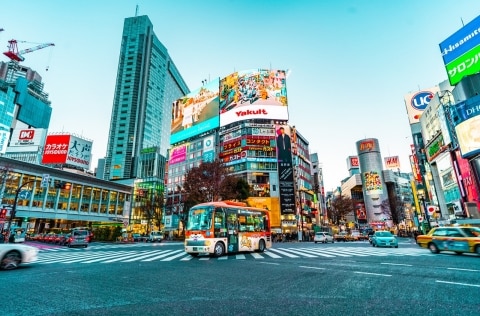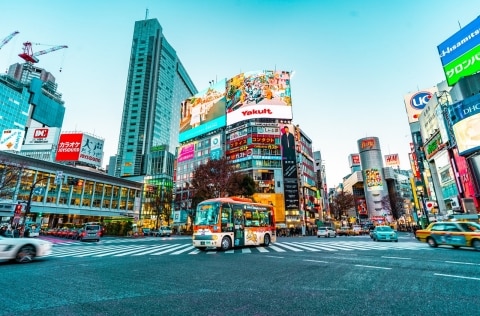18 Ways to Explore Tokyo Without Spending a Cent
From experiencing an early morning adrenaline rush at the Toyosu Fish Markets tuna auctions to finding a moment of silence by learning the art of origami, there are plenty of activities in the bustling city of Tokyo that don't cost a cent. Here's our shortlist of the best free things to do in Tokyo.

Image credit: Getty Images
Get that shot at the Shibuya Crossing
1/19There are few places more iconic than the busy Shibuya Crossing, where a green figure sends pedestrians sprawling onto the zebra lines from all four directions like a swarm of ants. Admire it from the footpath, walk across it yourself or, to avoid being crushed by the commuting masses, head up to the indoor walkway of Shibuya Station to get a bird’s-eye view (and the perfect photo).
Image credit: Getty Images/iStockphoto
Take a turn in a public park
2/19Where do Tokyo’s residents get their dose of shinrin-yoku (‘forest bathing’) in the concrete jungle? At one of the city’s pre-eminent public parks. There’s a green space for every season in this city; Yoyogi Koen for the ginko tree leaves that run crimson during autumn; Ueno Park for sakura (cherry blossom season); Rikugien for water feature elegance when flora is hibernating in winter; and Showa Memorial Park for getting into the summer spirit.
Image credit: Getty Images/iStockphoto
Explore the Imperial Palace
3/19Amid the seething modernism of Tokyo’s heart is the peaceful Imperial Palace, a castle that houses the country’s royal family. Walks within the Imperial Gardens (that encircles the castle) lead you over arched stone bridges and through the spread of 2000 sculptural Japanese black pine trees, as the city winds energetically around you in the distance.
Take a ride on a wasen
4/19Once a week (the day depends on the season), a group of volunteers take tourists for a float in a wasen – a traditional Japanese wooden boat – down the Yokojukken River in Yokojikkengawa Shinsui Park. Accompanied by two members from the Wasen Tomo no Kai group, you’ll meander down the canal, with the scenic surrounds of the Yokojikkengawa Shinsui Park lapping at the shores.
Image credit: Getty Images/iStockphoto
‘Gram a bamboo forest
5/19You could wander Chikurin Park for in peace, or you could head there for an unbeatable photo opp; it’s up to you. Either way, the 2000-strong thick-stem bamboo forest is truly a sight to behold and a reminder of the natural beauty of the city that often gets lost amid the crowds of kawaii characters. The park boasts a natural spring water stream babbling through it as well as a sizeable firefly population during summer. Open 24 hours a day, it’s great for the time-poor tourist.
Image credit: Alamy Stock Photo
Admire the view
6/19Dubbed so for its bright orange facade, you’d be hard-pressed to miss Carrot Tower, near Sanjenaya Station. This unassuming residential tower hides a secret: on its 26th floor is a lounge and observation area that allows visitors a view over the urban sprawl of the city, free of charge.
Image credit: Getty Images
Take a breath at Sensō-ji Temple
7/19Sail-like roofs flaring from stacked pagodas. Swinging lanterns of fire engine red to honour the colour of life. A 200-metre run of stalls selling snacks or souvenirs, trade as flourishing as it would’ve been hundreds of years ago. This is the scene at Sensō-ji Temple, one of Tokyo’s most popular Buddhist temples. The temple grounds are always open and the main hall keeps hours perfect for the visitors trying to pack a lot into a day’s activities, opening from 6am. Admission is, of course, free.
Image credit: Bloomberg via Getty Images
Take a brewery tour
8/19Although Suntory whisky gained additional fame for its cameo in Lost in Translation, the brand also makes great beer and you can sample some for free during an hour-long tour of its brewery in Fuchu – just make sure you reserve your spot in advance. You’ll be taken through the different hops that flavour the ale, as well as the packaging area where production lines efficiently sort and send off crates of the good stuff. The highlight of course is the tasting, during which you’ll try three brews from the daily selection.
Image credit: Getty Images/iStockphoto
Immerse yourself in the art of origami
9/19The ultimate antidote to the work-centric culture of Japan, the art of origami requires concentration, patience and a chunk of uninterrupted time. Should you have any on your trip, a visit to Origami Kaikan, or the International Origami Centre gives you the chance to not only observe intricate works of origami but also take part in workshops.
Image credit: Alamy Stock Photo
Do some people-watching in Yoyogi Park
10/19Although Yoyogi Park encases Tokyo’s most visited shrine, Meiji Jingu, the park itself isn’t the city’s most picturesque. The characters that frequent the park, however, are what make it a worthy tourist spot. On weekends, the park floods with people passing through from nearby Harajuku so you’ll often find groups of women dressed almost as living dolls, as well as frisbee throwers and, on Sundays, the clusters of Rockabilly dancers who channel 1950s fashion and groove to jukebox classics.
Image credit: CC BY-NC-ND 2.0 ©Garrett Ziegler
Experience underground art culture
11/19The exterior of SCAI the Bathhouse, a 200-year-old building and former bathhouse, captures minimalism at its best – so much so that you might walk past the stark white building altogether. Inside however, the rotation of works by contemporary Japanese artists (and international counterparts, too) among the permanent collection are vibrant and fascinating. The history of the building still lingers, too: the wooden lockers where guests would originally house their shoes before bathing is one such example.
Image credit: Bloomberg via Getty Images
Wander the Toyosu Fish Markets
12/19After 80 years at its original location, the ever-animated fish market (formerly the Tsukiji Fish Market) was moved to a new site further east. It still teems with the frantic urgency of sushi chefs and street stall owners all bustling in for the freshest produce in the city. The highlight of a trip is undoubtedly the early morning tuna auctions – visitors are required to apply for attendance beforehand, though.
Image credit: Alamy Stock Photo
Attend a sumo practice
13/19Sumo tournaments are notoriously difficult (and expensive) to attend but if you can enlist the help of a Japanese speaker such as your guide, you’ll have the opportunity to watch these athletes in action for free. The stables where sumo wrestlers live and practice are concentrated in Tokyo’s Ryogoku neighbourhood and every morning for three or four hours from 5am, some practices are open to a small number of visitors.
Pick up some free magazines
14/19Budget conscious travellers should bookmark this “store” in Nakameguro. Stocking a staggering array of exclusively free magazines, visitors can flick through the impressive catalogue at Only Free Paper – across niche zines to sleek monthlies – and walk away with as many unique souvenirs as your suitcase can handle (provided they’re not of the same title).
Image credit: Kyodo News via Getty Images
Understand Japanese consumer culture
15/19It may seem like a dry subject but trust us: this colourful, quirky and extensive Advertising Museum is worth a poke through – and not just because entry is free. Advertising in Japan is represented almost in its entirety; think early Edo era (1600s onwards) paintings made for Japanese paper screens all the way up to modern posters. There’s also a digitised section in addition to the curious collections on the walls.
Image credit: Getty Images/iStockphoto
Sip sake
16/19A veritable shrine to everything sake, the Japanese Sake and Shochu Information Centre explores the popular rice wine through seemingly endless channels at no cost. There are more than 6000 books on the subject, informational videos taking you through the ins and outs of the liquor and an on-site sake concierge to quiz with all your burning questions. The medium you’ll likely be most interested in? The tasting, available for a small fee.
Image credit: Getty Images/iStockphoto
Let a local lead you around
17/19Forget wandering the streets while frantically flipping through a guidebook. Japan Tourism has a volunteer scheme that pairs visitors with guides who will lead them through the city and provide insight on local customs and culture for a few hours or half a day. Although any necessary transportation costs for your guide should be covered, the enthusiastic, knowledgeable service of your new local friend is provided completely free of charge.
Image credit: Getty Images
Soak up the atmosphere in Harajuku
18/19All (stylish) roads lead to Harajuku, just west of Shibuya, where niche trends and outlandish threads intersect. It’s here that kawaii culture was born and if you want the jump on the next micro-trend, take a wander through the boutiques and amid the crowds of carefully dressed locals.















